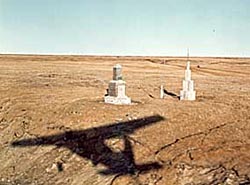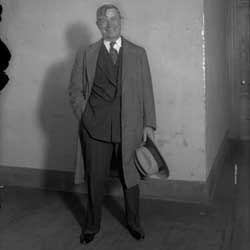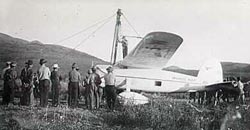
Two monuments at the Rogers-Post Site in Barrow, Alaska, memorialize the fatal August 16, 1935 aviation crash that claimed the lives of prominent Americans Will Rogers and Wiley Post. Will Rogers--actor, author, pundit and homespun philosopher, once called by the New York Times "the most widely-known citizen of the U.S. . . . and the best beloved" was also preeminent in the advancement of air transportation. Wiley Post, holder of two around-the-world aviation flight records, had contributed prominently to the advance of international aviation, including the study of the sub-stratosphere. Both Houses of Congress suspended deliberations upon learning of Rogers and Post's deaths, and a period of national mourning followed with messages of condolence issued by leaders and governments throughout the world.

Neither Rogers nor Post was a stranger to Alaska. This particular flight was described by the Associated Press as a "happy-go-lucky aerial tour of Alaska," which would be a prelude to a planned important pioneering trans-Siberian flight to Moscow. The two men had visited several Alaskan cities. On August 16, Rogers and Post were flying from Fairbanks to Barrow when they encountered fog and low-visibility. The two friends located a hole in the fog at Walakpa Bay, landed, spent some time with a small party of Alaska Natives and received directions for the short distance remaining to fog-shrouded Barrow. The final flight was barely airborne--perhaps 50 feet--when the motor failed. The aircraft plummeted into the lagoon and overturned. The Post-Rogers crash was the first fatal air accident Barrow had known.

Born in Texas in 1899, Wiley Post's internationally recognized career followed his unexpected win as an unknown of the 1930 National Air Race from Los Angeles to California. In the years preceding the crash, Post had stopped in Alaska for refueling during his two round-the-world flights. In 1931 he landed his plane, Winnie May, at both Fairbanks and Solomon Beach, near Nome with his navigator Harold Gatty. Then in a solo flight that bettered his time by almost a day he landed Winnie May at Fairbanks again, and at Flat, in the summer of 1933. The airplane that Post and Rogers were flying in 1935 was an advanced version of the Winnie May, but designed by Post. It was a low-wing cantilever monoplane of wood and fabric construction using a 55-horse power, Pratt and Whitney Wasp Engine. The fuselage was Lockheed Orion and the wing Sirius, similar to the airplane flown across the Pacific to Japan earlier by Charles and Ann Lindbergh. For Alaskan and Siberian conditions, in addition to landing wheels, it carried interchangeable skis and pontoons, and was described by the Army Signal Corps radio out of Barrow to Seattle as a "red, Arctic Sky Crusier."
The first monument at this site was dedicated just three years after the tragic crash, organized through public subscription from thousands of Americans. The Will Rogers-Wiley Post monument was designed in Oklahoma and built on the site with poured concrete using local aggregate. The design was essentially two cubes--the smaller atop the larger--with a pink granite memorial marker quarried near the Rogers' family homestead at Claremore, Oklahoma. The elaborate dedication ceremonies involved a four-way Columbia Broadcasting radio program from the Nation's capitol, the statehouses of Oklahoma and Texas and from Barrow and Walakpa, Alaska. The second monument was built 15 years later by Jesse Stubbs. More slender and almost 10 feet taller than the first, it was constructed as an obelisk entirely of poured concrete in four rectangular, diminishing blocks. Little is known of Stubbs, who arrived in Anchorage with the intention of walking from there to Barrow in the summer of 1953. Claiming to be a childhood friend of Rogers, although no records attest to this, the 72-year-old man personally erected the obelisk. It memorializes not only Rogers and Post, but also the Alaskan veterans of World War II. Both monuments overlook the lagoon crash site.
Visit the National Park Service Travel American Aviation to learn more about Aviation related Historic Sites.
Last updated: September 3, 2017
